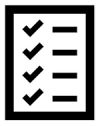Learning Objectives
By the end of this module, you should be able to:
- Determine how you can segment your customers
- Define Total Available Market (TAM) and Served Available Market (SAM)
- Calculate the TAM and SAM for your business idea using a variety of data sources
- Understand the process and reasons for a competitive analysis
- Perform a competitive analysis for your business
- Determine if you would like to move forward with your startup idea
Although we have filled out both our BMCs and Value Proposition Canvases with our customer segments, we have not really explored how we actually segment our customers. Segmenting customers helps by outlining their common attributes so that we have a more manageable group pf people that are much more likely to buy the product. We can choose an almost unlimited set of variables or bases on which to segment customers. Most of the time people think of segmenting customers by age, income, or geographically. While these are great places to start, some other ways to segment customers could be:
- Demographic variables likes age, gender, ethnicity, income, education, religion, and occupation
- Psychographic variables like personality, hobbies, goals, lifestyle, beliefs, values, interests
- Geographic variables like country, region, city
- Behavioural variables like spending habits, how they adopt new technologies, browsing habits, loyalty

Although this is a good list to get someone well on their way to understanding their customers, there are more possibilities in which to segment your customer. A helpful way is to picture your ideal customer – the most likely person to buy your product or service. It isn’t very helpful to simply say “well, anyone can buy my product”. While this is true, you will only have so many resources to try and reach customers, so you’d better make sure you spend your time, effort and money on the ones most likely to buy. Describing the ideal customer is to describe their archetype. The following video helps explain this idea:
Take the time to try and describe your customer archetype(s). As a startup, there may be more than one segment, but try to limit the number of segments you target. The more thinly you spread your attention, the more difficult it can be to effectively reach each segment.
A considerable challenge is to determine how large of a market your business serves. It is possible to get an estimation of this number (either as number of people or in dollars) through some creative exercises, which we will cover here. To start, let’s explore the concepts of TAM and SAM. To start, TAM is essentially referring to your target market potential, or how large the “pie” is for your business. SAM is your likely share of that pie. It is like other terms like market share, or market penetration rate. The video below explains:
As the video mentions, there are several ways to try and get these numbers. Ideally, you should talk to customers, however we will discuss ways to determine this using other secondary/online data. The better the data you can get, the more realistic your market estimate.
Estimating your market size can be completed through five steps, as outlined by the reading from the MaRs Startup Toolkit. A summary of the steps are found below (Read: How to estimate market size: Business and marketing planning for startups https://learn.marsdd.com/article/how-to-estimate-market-size-business-and-marketing-planning-for-startups/ ):
- Define your target customer: we should have a good idea of this step from this module and the previous one.
- Estimate the number of target customers (similar to TAM): this step can be completed through using secondary data, and we will discuss resources to help accomplish this.
- Determine your penetration rate: the market penetration rate is the estimated size of market that your business could take of the total market. Be careful with this step, as people often overestimate this number. Be critical in your own judgements, and consider how you could achieve this rate.
- Calculate your market volume and value: this number can be found by multiplying your number of target customers by your penetration rate. By further multiplying this number by the average transaction value of your product you can get the value of the market.
- Apply the data and monitor: You should evaluate what your estimate means for your business model. You should also realize that your numbers have a fair number of assumptions built in. Write these assumptions down and consider how changes in these assumptions through research would change your market size.
There are many resources that can be used to estimate the size of a market within newfoundland and Labrador. We will also list a few others to estimate the size of a broader market. The table below offers some examples across several industries:
Resource
Possible Uses
Note: MaRs also has a more detailed list of reports within Stats Can: https://learn.marsdd.com/article/find-canadian-market-data/
The starting point for any estimate on market size or number of registered businesses in certain areas. Do not underestimate its value!
Use for statistics on small business, labour market etc.
The second step for any market size estimation in the province. This site includes community profiles, retail sales numbers, income levels and spending.
Statistics – Information on visitor numbers, geographic information for Newfoundland & Labrador.
Insights – Tourism insights on the government of NL website also contains links to national and international tourism research.
Search the frequency of certain keywords/products across different geographical areas.
Google Play/App Store – available on most smart phones
Record the number of downloads for types of applications, collect qualitative feedback on competitors.
Access through MUN library databases
(Accessible to MUN students and Navigate program manager)
Large database with access to hundreds of market industry reports, country reports, consumer reports etc.
The Passport database
Access through MUN library databases
(Accessible to MUN students and Navigate program manager)
Large database with access to hundreds of market industry reports, country reports, consumer reports etc.
It is impossible to list all the sources here, as there may be many that apply to your specific industry. You may wish to contact the Navigate Program manager for further research.
Competition is an important part of business and of your value proposition. There are some valid points against not worrying about competition. These views often say that if an entrepreneur focuses on executing their own business, then they will do fine – often taking too much time and effort to worry about competition can actually take your focus away from what is truly important. While there is some truth to this, it is good idea to at least screen the market for existing businesses that may be your competitors. This can help you figure out which industries are the most competitive, if there any ideas out there like your own, and if there are ways that you can stand out from these businesses.

At this stage, you will complete a competitive analysis. The table below provides a template for you to complete the analysis. To help with this, we will define the different dimensions on which you can compare your competition.
Indirect vs direct competitors: Competition can either be direct or indirect (more detailed analyses offer three or more categories of competitors). Direct competitors offer a very similar product to a similar audience. These are often the easiest to identify. An example would be two adjacent restaurants offering similar types of food. Indirect (sometimes called replacement) competitors are often after the same customer dollar than yours, but may be different products. In a similar example, indirect competitors might be a campground versus cabin rentals. Although they are significantly different types of offerings, they are competing over a traveller’s lodging dollars.
Summary of offering: Summarise the value proposition of the competitor.
Position: The market position is how the competitors stack up compared to others based on the price versus the quality. For example, we might consider Chaga Rum from the Newfoundland Distillery to be of mid-to-high range quality and a mid-range price in Newfoundland. This could compare to Ragged Rock which site slightly lower on both dimensions.
Price point: What does the competitor charge for the offering listed above?
Target audience: What is(are) is the likely customer segment(s) of the competitor?
Physical location: Where is the competitor located? Do they have more than one location? If they are online only, what is the address?
Sales channels: Where can you buy the product? Are the channels physical or virtual?
Competitive Advantage: What sets this business apart and is unlikely for competitors to be able to copy?
Marketing strategy/tactics: Where does the competitor communicate with its customers? What types of messages and what types of promotions do they offer?
Strengths: What other types of strengths does the competitor have?
Weaknesses: What shortcomings does the competitor have?

- Name the customer segment(s) for your business idea, and describe the segment in as much detail as possible using several segmentation bases. If possible, write a customer archetype.
- Using your defined customer segment, estimate the size of your market using secondary sources. How large is the market? Do you feel that it is large enough to continue with the idea?
- If you answered “no” above, that is okay. It may require you to revisit your idea, or to change some of the assumptions in the estimate of your target market. Revisit some of the earlier steps to do this.
- Complete a competitive analysis using the table from this module. You might have to be creative in how you find this information. You might choose to Google what businesses are nearby, or do some sleuthing through what you find in a classic Google search. Company websites and social media platforms might also have good information on marketing tactics. Finally, if there are websites that offer reviews of products or services, you might be able to get information from the reviews themselves to determine the competitor’s strengths and weaknesses. Sites like Airbnb, Amazon, Hotels.com or the App store serve different types of markets.
- Summarize how your business idea stacks up against the competition. Does it stand out? Is there a clear reason why customers would choose your businesses over the others? Is there a segment or offering that you are addressing or offering that competitors are not?
- At this point, you have a decision to make. Have a look back at your value proposition and customer segments, your business model canvas, your market size estimation. Compare them alongside the summary for your competitive analysis. Do you feel that you have a good product market fit? Is there a large enough market to justify pursuing the idea? Do you have a clear way to stand out from competitors? If so, you can choose to continue onto Section 3 of the course. If not, that is okay – this is part of the process! You may go back to your ideation of you would like to make some adjustments and repeat the process from Sections 1 and 2.
In section 2, we have taken a deeper dive on the value proposition and customer segments. By understanding our customers in detail, we can estimate our potential market size and our served available market. We may have had to adjust our BMCs based on what we learned, but this is all in the name of improvement. Keep these deliverables for now, as you will have to go back and change them as we pivot and iterate upon validating our business model. In the next section, we will build a minimum viable product (MVP), get out of the building to speak with potential customers, and learn from our feedback.

